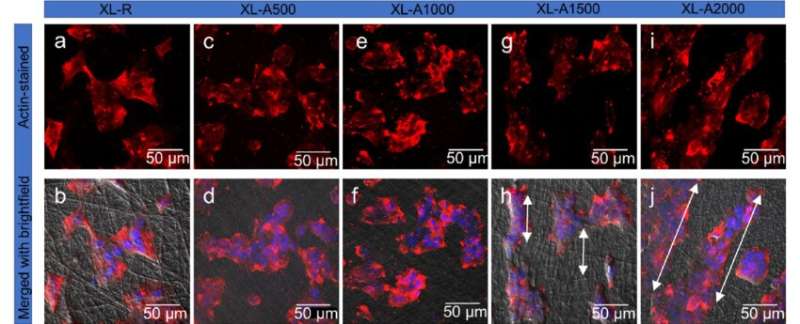Morphological assessment of keratinocytes. A total of 1.5 × 10. 4 cells/well were seeded on the samples in 24-well plates. The images were taken after 4 days of incubation. Confocal images of a, b XL-R, c, d XL-A500, e, f XL-A1000, g, h XL-A1500, i, j. Credit: Advanced Fiber Materials (2022). DOI: 10.1007/s42765-022-00216-w
A team of researchers from Singapore has reported the development of a skin-mimicking scaffold by parallelly aligning nanofibers made up of a mixture of polycaprolactone (PCL) and gelatin that enhances wound healing. Their research has recently been published in Advanced Fiber Materials.
When the skin is injured, it can take a while to heal, depending on the level of injury. Bacteria present in the skin flora or from external sources migrate to the injured sites and their heightened presence delays the healing process. Infected wounds often take several weeks to heal.
Emerging multidrug-resistant (MDR) bacteria further adds to the health burdens in wound care and represents a major healthcare problem. Wound management costs billions of dollars every year worldwide. In addition, delayed wound healing adds to the suffering of many people and their well-being.
With the goal of accelerating the wound healing process, researchers prepared a novel composite dressing. They used two basic ingredients—PCL, which is a biodegradable polyester, and Gelatin, a biodegradable protein made from denatured collagen. They applied the electrospinning method to fabricate fibers made of PCL/Gelatin.
They then incorporated a skin-compatible naturally occurring poly(amino acid) polymer, called ε-polylysine, into the fibrous scaffold. Researchers have earlier established excellent broad-spectrum anti-infective properties of ε-polylysine. In addition, they showed that ε-polylysine enhances the motility of skin cells—dermal fibroblasts and keratinocytes.
"The idea of adding ε-polylysine to the nanofibrous scaffolds was to prevent bacterial colonization at the injured site. We leveraged our experience in designing durable antimicrobial nanofibers. The nanofibrous composite dressing prevented bacterial infection and effectively accelerated wound healing. This is mainly because the electrospun material mimicked the structure and properties of the natural skin, providing a suitable microenvironment on the wound bed," said Dr. Rajamani Lakshminarayanan, Singapore Eye Research Institute (SERI), one of the lead PI of the study.
To further increase the mechanical strength, robustness, and durability of the scaffolds, researchers cross-linked the fibrous scaffolds using a chemical, called dopamine hydrochloride. Dressings made from these fibers were smooth, continuous, and bead-free, with a mean diameter that is supportive of skin cells. Moreover, nanofibrous mats were highly hydrophilic, which is crucial for enhancing dermal cell adhesion, polarization, migration, and thus wound dressing.
"By controlling the speed of the rotating drum collector of the electrospinning system, we were able to tune fiber alignment," said Mr. Erfan Rezvani Ghomi, a Ph.D. student at the National University of Singapore (NUS) and the first author of the paper.
"The fiber alignment of the scaffolds improved their tensile strength and imparted hydrophilicity, i.e., creating a moistening environment, a desirable feature of wound dressing that can absorb excessive wound fluid allowing better cell growth, proliferation, and migration."
Researchers experimented with different topologies of electrospun nanofibers using the in vitro cell culture system. When researchers arranged the fibers in a parallel topology, they were able to increase cell proliferation and the movement of cells in the direction of alignment, while fibers with random topology slowed cell motility.
The extracellular matrix consists of fibrous structures through which skin cells move.
"If we create and apply a similar structure on the injured tissue, it will provide a favorable microenvironment, support cell movement, and thus enhance wound healing. Our findings that applying parallelly aligned PCL/Gelatin scaffolds enhances cell migration would help in improving treatment outcomes of wounds and provide hope that new and better dressing could be developed to improve healing. We are continuing our research efforts and actively developing new scaffold designs tuned for regulating inflammation in the wounds," said Assistant Professor Navin Verma, Nanyang Technological university Singapore (NTU), one of the lead PI of the study.
"A simple electrospinning technique was used in the current work to create dressing. The wound care industry is looking for this kind of innovative bioengineered materials. A simple next step would be to add more functionalities to this highly aligned fiber material such as anti-inflammatory properties," said Professor Seeram Ramakrishna, NUS.
Although various dressings based on hydrogels, and other materials loaded with bioactive agents were developed for wound healing, the efficiency of these dressings was limited to their composition. But an important aspect about the biological influence of structure and topography is less studied.
Professor S. C. Kundu, Research Coordinator and Former European Research Area Chair, Research Institute on Biomaterials, Biodegradables and Biomimetics, at the Headquarters of the European Institute of Excellence on Tissue Engineering and Regenerative Medicine, University of Minho, Portugal, who was not involved in the study, said, "fiber fabrication designs will help us to improve treatments, which would provide wound patients with better benefits. Rapid wound healing is particularly desired in the case of chronic wounds or severe burns. But more research needs to be done."
Highlighting the significance of the current work, the research team said, "Our study offers a general framework for future research, and we are beginning to explore the opportunities. We are now looking to develop this technique to the next stage that could lay the groundwork for new approaches in dealing with wound repair."
More information: Erfan Rezvani Ghomi et al, Electrospun Aligned PCL/Gelatin Scaffolds Mimicking the Skin ECM for Effective Antimicrobial Wound Dressings, Advanced Fiber Materials (2022). DOI: 10.1007/s42765-022-00216-w
Provided by Nanyang Technological University Singapore
























